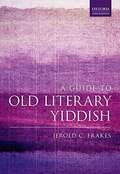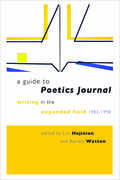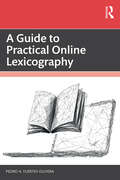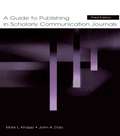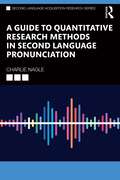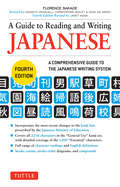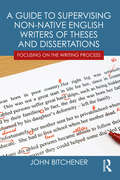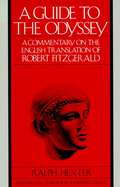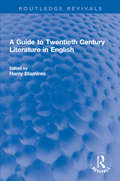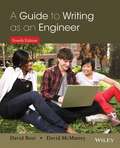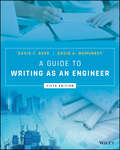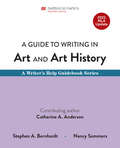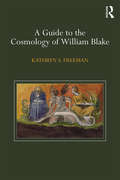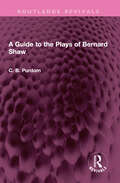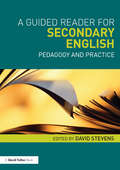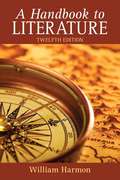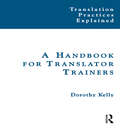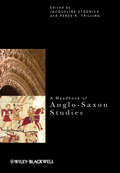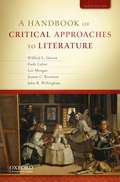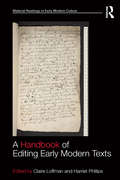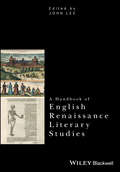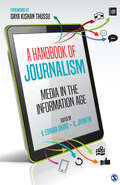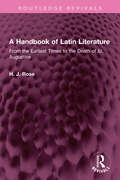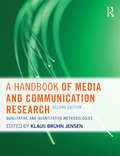- Table View
- List View
A Guide to Old Literary Yiddish
by Jerold C. FrakesThis book is a comprehensive introductory manual that guides beginners to a functional reading knowledge of late medieval and early modern Yiddish (c.1100-1750). It is the first such manual to exist for that language, whose early literary tradition comprises a range of genres as broad as other contemporary European literary traditions. <p><p>The guide is organized as a series of progressively more complex lessons, focused on key texts of the literary corpus, which are presented in their authentic form as found in manuscripts and early printed books. The lessons seek to accommodate readers ranging from absolute beginners to those who might already know Hebrew, medieval German, or modern Yiddish. The focal texts are the Old Yiddish midrashic heroic lay,'Joseph the Righteous', from the earliest extant manuscript collection of Yiddish literature (1382), the Middle Yiddish romance adventure tale, 'Briyo and Zimro', from a later collection (1585), and a full canto of the Middle Yiddish epic, Pariz and Viene (1594), each with full glosses and a step-by-step introduction to the morphology, syntax, and phonology. Each lesson also includes a brief supplemental text that cumulatively demonstrates the broad cultural range of the corpus. In addition, several appendices of supplementary material round out the volume, including a collection of additional readings, a table of the manuscript hands and printing fonts employed in the volume, and a full end-glossary of all Yiddish words found in the texts.
A Guide to Poetics Journal: Writing in the Expanded Field, 1982–1998
by Lyn Hejinian Barrett WattenLyn Hejinian and Barrett Watten are internationally recognized poet/critics. Together they edited the highly influential Poetics Journal, whose ten issues, published between 1982 and 1998, contributed to the surge of interest in the practice of poetics. A Guide to Poetics Journal presents the major conversations and debates from the journal, and invites readers to expand on the critical and creative engagements they represent. In making their selections for the guide, the editors have sought to showcase a range of innovative poetics and to indicate the diversity of fields and activities with which they might be engaged. The introduction and headnotes by the editors provide historical and thematic context for the articles. The Guide is intended to be of sustained creative and classroom use, while the companion Archive of all ten issues of Poetics Journal allows users to remix, remaster, and extend its practices and debates.
A Guide to Practical Online Lexicography
by Pedro A. Fuertes-OliveraA Guide to Practical Online Lexicography provides a step-by-step course on digital lexicography, discussing state-of-the-art theoretical lexicography and offering a guide to practical lexicography, with a focus on monolingual online dictionaries.Dictionaries today need to be designed and made for online environments, use up-to-date technologies in all aspects of lexicography, and have adequate business models in place for financing them. This book:• Covers lexicographic data and categories of existing online dictionaries, and shows how to plan, analyse, and store data.• Discusses the relationship between technology, dictionary users and dictionary makers, lexicographic developments, and economic costs.• Provides an in-depth case study of designing and making the Diccionario Digital del Español (DIDES), an online dictionary of Spanish edited by the author.• Includes further reading recommendations, practical activities, and questions for discussion at the end of each chapter.Drawing on materials developed by the author from his experience of over 20 years of lecturing in universities and institutions globally, this is a practical go-to guide to online lexicography for students of lexicography, e-lexicographers and researchers.
A Guide to Publishing in Scholarly Communication Journals (Published for the International Communication Association)
by John A. Daly Mark L. KnappThis guide offers detailed advice on the journal article publication process, describing each step of the process and providing insights for improving the presentation of work intended for publication in communication journals. It includes advice from journal editors across the discipline and offers resource materials to help both new and seasoned writers publish their work. The guide begins with an overview of the publication process, followed by a discussion of each step of the manuscript submission, review, and revision processes. In addition to reality-based answers to questions often posed to editors, resource materials are provided in the appendices, introducing readers to the various forms and correspondence they will encounter when they submit their work for consideration. The guide focuses on the issues and procedures associated with the publication process, examining rules and expectations encountered during the publishing process that are often assumed to be known but are rarely articulated. The guidance provided here will aid in establishing consistency in publication practices and will contribute toward improving the quality of journal submissions, as well as enhancing interaction with editors and reviewers. As a guide to demystifying procedures associated with the publication process, this resource will serve all academic authors desiring to publish their work in scholarly communication journals.
A Guide to Quantitative Research Methods in Second Language Pronunciation (ISSN)
by Charlie NagleThis book offers a comprehensive resource on the state-of-the-art in L2 pronunciation, surveying the most up-to-date theoretical and methodological developments to highlight the multidimensional nature of pronunciation scholarship and directions for future research. The volume examines both speech perception and production, including the perception-production link. The book explores production from a range of perspectives, including acoustic analysis of specific features and listener-based ratings of global dimensions of pronunciation. Each chapter spotlights a different dimension of pronunciation through a consistent structure, including a summary of the latest research, a critical appraisal of methods, and an overview of data analysis procedures with recommendations for practical implementation. The innovative interconnected structure allows readers to build on their knowledge with each successive chapter while also allowing the flexibility to use chapters as standalone units depending on individual interests. A concluding chapter outlines a research agenda for future scholarship, spotlighting the methods and approaches that are most likely to advance the field. This book is an invaluable resource for graduate students and researchers, at all stages of their careers, looking to expand their knowledge base in SLA and L2 pronunciation and related fields such as phonetics and phonology.
A Guide to Reading and Writing Japanese
by Janet Ikeda Kenneth Henshall Christopher Seeley Henk De GrootThis is an essential study tool for students seeking to learn Japanese and dramatically improve their kanji and kana. Students have been reading and writing Japanese for centuries, and they build their knowledge most successfully when they rely on a trusted resource. Today's most trusted-and readily available-resource is A Guide to Reading and Writing Japanese. This classic, best-selling learning and reference work, trusted by beginning and intermediate students learning Japanese since 1959, is now being offered as a fourth edition and is thoroughly revised and up-to-date. Having a knowledge of the full set of General Use characters, which this guide includes, will allow reading of any Japanese newspaper with ease and confidence. Key features on this revised edition include: The most recent changes prescribed by the Japanese Ministry of Education. Covers all the 2,136 characters in the 'General Use' / Joyo Kanji set. Detailing coverage of the 1,009 'Essential' Japanese characters arranged by grade for children in the first six years of grade school. The Kanji characters based more on their frequency in everyday language than the complexity of their composition.
A Guide to Sources of Information on the National Labor Relations Board (Research and Information Guides in Business, Industry and Economic Institutions)
by Gordon T. Law M. P. CatherwoodA concise history of the board in the U.S. from its inception in 1935, including an overview of current case law, and a bibliographic essay of selected secondary literature about the board.
A Guide to Supervising Non-native English Writers of Theses and Dissertations: Focusing on the Writing Process
by John BitchenerFocused on the writing process, A Guide to Supervising Non-native English Writers of Theses and Dissertations presents approaches that can be employed by supervisors to help address the writing issues or difficulties that may emerge during the provisional and confirmation phases of the thesis/dissertation journey. Pre-writing advice and post-writing feedback that can be given to students are explained and illustrated. A growing number of students who are non-native speakers of English are enrolled in Masters and PhD programmes at universities across the world where English is the language of communication. These students often encounter difficulties when writing a thesis or dissertation in English – primarily, understanding the requirements and expectations of the new academic context and the conventions of academic writing. Designed for easy use by supervisors, this concise guide focuses specifically on the relationship between reading for and preparing to write the various part-genres or chapters; the creation of argument; making and evaluating claims, judgements and conclusions; writing coherent and cohesive text; meeting the generic and discipline-specific writing conventions; designing conference abstracts and PowerPoint presentations; and writing journal articles.
A Guide to The Odyssey: A Commentary on the English Translation of Robert Fitzgerald
by Ralph HexterFor those of us who know and love the incomparable Odyssey of Homer (and there are many), Dr. Hexter has created a valuable, detailed analysis, taking into account many of Homer's most fascinating subtleties.
A Guide to Twentieth Century Literature in English (Routledge Revivals)
by Harry BlamiresFirst published in 1983, A Guide to Twentieth Century Literature in English is a detailed and comprehensive guide containing over 500 entries on individual writers from countries including Africa, Australia, Canada, the Caribbean, India, Ireland, New Zealand, Pakistan, Sri Lanka, and the UK. The book contains substantial articles relating to major novelists, poets, and dramatists of the age, as well as a wealth of information on the work of lesser-known writers and the part they have played in cultural history. It focuses in detail on the character and quality of the literature itself, highlighting what is distinctive in the work of the writers being discussed and providing key biographical and contextual details. A Guide to Twentieth Century Literature in English is ideal for those with an interest in the twentieth century literary scene and the history of literature more broadly.
A Guide to Writing as an Engineer
by David Mcmurrey David BeerWritten for engineers, this book provides more than technical know-how and focuses on how to be an effective communicator. This new edition helps to eliminate the glitches that trip up the busy reader or listener, causing annoyance, confusion, or misunderstanding'so that their writing and speech are crystal clear. This text also focuses on the technical writing and speaking issues encountered in day to day work, writing reports, business letter, memoranda, proposals, emails, presentations, and more. The new edition includes new coverage of social media, including coverage of popular forms, best practices, dangers and ethics of using social media, and expanded coverage of informal communication.
A Guide to Writing as an Engineer
by David Beer David McMurreyEveryone knows that engineers must be good at math, but many students fail to realize just how much writing engineering involves: reports, memos, presentations, specifications―all fall within the purview of a practicing engineer, and all require a polished clarity that does not happen by accident. A Guide to Writing as an Engineer provides essential guidance toward this critical skill, with practical examples, expert discussion, and real-world models that illustrate the techniques engineers use every day. <P><P>Now in its Fifth Edition, this invaluable guide has been updated to reflect the most current standards of the field, and leverage the eText format to provide interactive examples, Engineering Communication Challenges, self-quizzes, and other learning tools. Students build a more versatile skill set by applying core communication techniques to a variety of situations professional engineers encounter, equipping them with the knowledge and perspective they need to succeed in any workplace. Although suitable for first-year undergraduate students, this book offers insight and reference for every stage of a young engineer’s career.
A Guide to Writing in Art and Art History with 2021 MLA Update: A Writer's Help Guidebook Series
by Nancy Sommers Stephen A. BernhardtThis ebook has been updated to provide you with the latest guidance on documenting sources in MLA style and follows the guidelines set forth in the MLA Handbook, 9th edition (April 2021).A Guide to Writing in Art and Art History, part of the Writer’s Help Guidebook Series, offers writing and research support for students writing in the discipline. This compact yet comprehensive guidebook provides the value students want with the essential instruction they need to complete writing tasks successfully. Students will find advice on how to think, read, research, and design and write papers and projects like an art professional.
A Guide to the Cosmology of William Blake
by Kathryn S. FreemanIt is not surprising that visitors to Blake’s cosmology – the most elaborate in the history of British text and design – often demand a map in the form of a reference book. The entries in this volume benefit from the wide range of historical information made available in recent decades regarding the relationship between Blake’s text and design and his biographical, political, social, and religious contexts. Of particular importance, the entries take account of the re-interpretations of Blake with respect to race, gender, and empire in scholarship influenced by the groundbreaking theories that have arisen since the first half of the twentieth century. The intricate fluidity of Blake’s anti-Newtonian universe eludes the fixity of definitions and schema. Central to this guide to Blake's work and ideas is Kathryn S. Freeman's acknowledgment of the paradox of providing orientation in Blake’s universe without disrupting its inherent disorientation of the traditions whereby readers still come to it. In this innovative work, Freeman aligns herself with Blake’s demand that we play an active role in challenging our own readerly habits of passivity as we experience his created and corporeal worlds.
A Guide to the Plays of Bernard Shaw (Routledge Revivals)
by C. B. PurdomFirst Published in 1963 A Guide to the Plays of Bernard Shaw is a descriptive and critical account of Bernard Shaw’s work as a playwright. The leading ideas contained in the plays are discussed because they are relevant to the work of the dramatist, and the author has also commented on their original production as they were mostly done under Shaw’s direction. Author argues that if Shaw were to be reincarnated as a dramatic critic he would only too often be as scathing of the treatment of his plays upon the stage today as was G.B.S. when writing of the Shakespeare productions in the London theatre. This book is a must read for students of English literature.
A Guided Reader for Secondary English: Pedagogy and practice
by David StevensThe Guided Reader for Secondary English draws on extracts from the published work of some of the most influential education writers to provide insight, guidance and clarity about key issues affecting Secondary English teachers. The book brings together key extracts from classic and contemporary writing and contextualises these in both theoretical and practical terms. The extracts are accompanied by a summary of the key ideas and issues raised, questions to promote discussion and reflective practice, and annotated further reading lists to extend thinking. Taking a thematic approach and including a short introduction to each theme, the chapters cover: Theoretical models of curricular English The nature and structure of the Secondary School English curriculum Historical perspectives Texts and intertextuality The arts context for secondary English Assessment and evaluation Linguistic and cultural contexts Future possibilities and tensions Aimed at trainee and newly qualified teachers including those working towards Masters level qualifications, as well as existing teachers, this accessible, but critically provocative text will be an essential resource for those that wish to deepen their understanding of Secondary English Education.
A Handbook To Literature (12th Edition)
by William HarmonThe definitive reference on literature in English, this handbook provides an alphabetical listing of more than 2,000 important terms and facts in literature, linguistics, rhetoric, criticism, printing, bookselling, and information technology.
A Handbook for Translator Trainers
by Dorothy KellyThe community of translator trainers is growing constantly, as new courses are set up in diverse contexts throughout the world. After a brief overview of current approaches to translator training, this book offers practical guidance to sound training practices in different contexts. Given the very wide variety of backgrounds translator trainers come from, the text aims to be equally of use to language teachers new to translation, to professional translators new to teaching or training, to recent graduates in translation intending to embark on academic careers in translation studies, and to more experienced trainers wishing to reflect on their activity or to train new trainers. For that reason, no specific prior knowledge or experience of training is taken for granted. A systematic approach to curriculum and syllabus design is adopted, guiding readers from the writing of learning outcomes or objectives through to the design of teaching and learning activities, to the assessment of learning and course evaluation, all this applied throughout in detail to the field of translation. Chapters contain exercises and activities designed to promote reflection on practice and to help trainers to develop their teaching skills, as well as their own course material. These activities are suitable both for self-learners and for groups on trainer training and staff development courses.
A Handbook of Anglo-Saxon Studies
by Renée Trilling Jacqueline StodnickReflecting the profound impact of critical theory on the study of the humanities, this collection of original essays examines the texts and artifacts of the Anglo-Saxon period through key theoretical terms such as OCyethnicityOCO and OCygenderOCO. Explores the interplay between critical theory and Anglo-Saxon studiesTheoretical framework will appeal to specialist scholars as well as those new to the fieldIncludes an afterword on the value of the dialogue between Anglo-Saxon studies and critical theory "
A Handbook of Critical Approaches to Literature
by Lee Morgan Earle Labor Wilfred L. Guerin Jeanne C. Reesman John R. WillinghamRanging from traditional approaches to the most contemporary perspectives, such as feminist and gender studies, cultural studies, and postcolonial studies, A Handbook of Critical Approaches to Literature offers readers a variety of clearly articulated approaches to interpreting literature. This thoroughly updated sixth edition applies these diverse approaches to the same six classic works--"To His Coy Mistress," "Young Goodman Brown," "Everyday Use," Hamlet, Huckleberry Finn, and Frankenstein--in a way proven to elicit student analysis by enriching their response to and understanding of the individual works and critical theory. (Andrew Marvell's poem "To His Coy Mistress," Nathaniel Hawthorne's story "Young Goodman Brown," and Alice Walker's story "Everyday Use" are included in full within this volume. )
A Handbook of Editing Early Modern Texts (Material Readings in Early Modern Culture)
by Claire Loffman Harriet PhillipsA Handbook of Editing Early Modern Texts provides a series of answers written by more than forty editors of diverse texts addressing the 'how-to's' of completing an excellent scholarly edition. The Handbook is primarily a practical guide rather than a theoretical forum; it airs common problems and offers a number of solutions to help a range of interested readers, from the lone editor of an unedited document, through to the established academic planning a team-enterprise, multi-volume re-editing of a canonical author. Explicitly, this Handbook does not aim to produce a linear treatise telling its readers how they 'should' edit. Instead, it provides them with a thematically ordered collection of insights drawn from the practical experiences of a symposium of editors. Many implicit areas of consensus on good practice in editing are recorded here, but there are also areas of legitimate disagreement to be charted. The Handbook draws together a diverse range of first person narratives detailing the approaches taken by different editors, with their accompanying rationales, and evaluations of the benefits and problems of their chosen methods. The collection's aim is to help readers to read modern editions more sensitively, and to make better-informed decisions in their own editorial projects.
A Handbook of English Renaissance Literary Studies (Critical Theory Handbooks)
by John LeeProvides a detailed map of contemporary critical theory in Renaissance and Early Modern English literary studies beyond Shakespeare A Handbook of English Renaissance Literary Studies is a groundbreaking guide to the contemporary engagement with critical theory within the larger disciplinary area of Renaissance and Early Modern studies. Comprising commissioned contributions from leading international scholars, it provides an overview of literary theory, beyond Shakespeare, focusing on most major figures, as well as some lesser-known writers of the period. This book represents an important first step in bridging the divide between the abundance of titles which explore applications of theory in Shakespeare studies, and the relative lack of such texts concerning English Literary Renaissance studies as a whole, which includes major figures such as Marlowe, Jonson, Donne, and Milton. The tripartite structure offers a map of the critical landscape so that students can appreciate the breadth of the work being done, along with an exploration of the ways in which the treatments of or approaches to key issues have changed over time. Handbook of English Renaissance Literary Studies is must-reading for undergraduate and postgraduate students of early modern and Renaissance English literature, as well as their instructors and advisors. Divided into three main sections, “Conditions of Subjectivity,” “Spaces, Places, and Forms,” and “Practices and Theories,” A Handbook of English Renaissance Literary Studies: Provides an overview of theoretical work and the theoretical-informed competencies which are central to the teaching of English Renaissance literary studies beyond Shakespeare Provides a map of the critical landscape of the field to provide students with an opportunity to appreciate the breadth of the work done Features newly-commissioned essays in representative subject areas to offer a clear picture of the contemporary theoretically-engaged work in the field Explores the ways in which the treatments of or approaches to key issues have changed over time Offers examples of the ways in which the practice of a theoretically-engaged criticism may enrich the personal and professional lives of critics, and the culture in which such critical practice takes place
A Handbook of Journalism: Media in the Information Age
by V. Eshwar Anand K. JayanthiJournalism as a discipline is becoming increasingly important today. It has to contend with new challenges such as the explosion of social media, heightened commercial competition in the mainstream media and the emergence of the media as a powerful actor in public policy and governance. The confluence of these factors calls for fresh thinking about the teaching and practice of journalism. A Handbook of Journalism: Media in the Information Age not only helps readers to understand today’s media environment but also prepares them to face the existing challenges. Distinguished editors, experts, academics and journalists join to examine these challenges from various angles, including some of the major contemporary trends, issues and processes in governance, institutions, administration and development, among others. The book fairly and objectively discusses a critical discipline that is at the crossroads.
A Handbook of Latin Literature: From the Earliest Times to the Death of St. Augustine (Routledge Revivals)
by H. J. RoseFirst published in 1954, A Handbook of Latin Literature is an attempt to put together a cohesive account of classical and early post-classical writings in the Latin tongue, and is a companion to the Handbook of Greek Literature. The book traces the history of Latin literature from the earliest times down to the death of St. Augustine, and tackles both theological and non-theological interests of Christian authors. This book will be of interest to students of history and literature.
A Handbook of Media and Communication Research: Qualitative and Quantitative Methodologies
by Klaus Bruhn JensenA Handbook of Media and Communication Research presents qualitative as well as quantitative approaches to the study of media and communication, integrating perspectives from both the social sciences and the humanities. Taking methodology as a strategic level of analysis that joins practical concerns with theoretical issues, the Handbook offers a comprehensive and in-depth review of the field and a set of guidelines for how to think about, plan, and carry out media and communication studies in different social and cultural contexts. The second edition has been thoroughly updated with reference to the development of the internet, mobile, and other digital media. Each chapter addresses shifting configurations of established media organizations, media discourses, and media users in networked practices of communication. The introduction and one further chapter probe changing conceptions on mass and interpersonal, online and offline communication – in research as in everyday life. Three new chapters have been added to exemplify different forms of research employing multiple methods to study multiple media in multiple contexts. List of contributors: Klaus Bruhn Jensen, Barrie Gunter, Rasmus Helles, Annette Hill, Stig Hjarvard, Peter Larsen, Amanda Lotz, Graham Murdock, Horace Newcomb, Paddy Scannell, Lynn Schofield Clark, Kim Christian Schrøder
